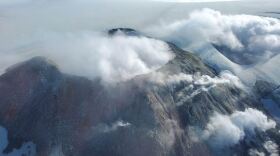Scientists have downgraded the alert level at Makushin Volcano after a sustained pause in unrest.
John Power, a geophysicist with the Alaska Volcano Observatory, said the seismicity has been steadily declining for months, following an earthquake sequence near the volcano that began in mid-June.
"We had a sequence of several earthquakes on June 15. There were two of them in particular that were above magnitude-4, which were felt strongly in the community of Unalaska/Dutch Harbor," Power said. "This initiated a sequence of small earthquakes that continued for several months."
The earthquakes were clustered about six miles east of the summit of the volcano at a depth of about five miles below the surface of the earth. The AVO has located 1,245 earthquakes near Makushin since then.
But on Tuesday,because seismic activity at Makushin has returned to background levels, Power said the AVO lowered the alert level from "advisory" to "normal," and the aviation color code from "yellow" to "green."
According to Power, when dealing with a volcano like Makushin that is fairly active, he would expect there to be some type of eruptive activity at some point in the future. But right now, he said, scientists see nothing that causes them any type of concern.
"These earthquakes have died away slowly over time. There hasn't been any increased steaming. Our GPS instruments and what we can see with satellite data don't indicate any other type of unrest," he said. "At this point in time, we see nothing to be concerned about here in the short-term. So in a way you would say that, right now, we've got a clean bill of health."
Power said sometime in the coming years or decades there will likely be renewed eruptive activity at Makushin, and the AVO will continue to monitor the volcano closely.
Makushin is located on northern Unalaska Island, about 16 miles west of the community of Unalaska. The broad, ice-capped stratovolcano is the site of frequent steam and minor ash eruptions, according to the AVO. But no large eruptions have occurred in this century.
Makushin is currently monitored by a network of seismic stations, web cameras, GPS, satellite images, and regional infrasound and lightning detection data.






